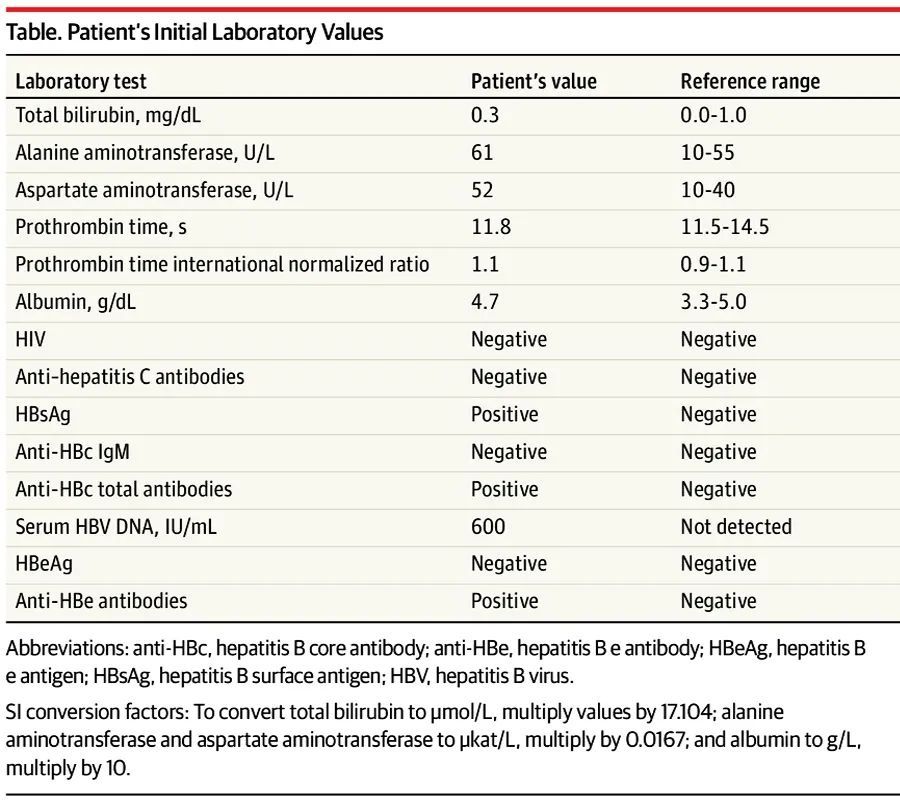Currently, the diagnosis of hepatitis B virus infection mainly relies on the determination of serum markers. Interpretation of hepatitis B serological test results is a basic skill in the practice of infectious diseases.
Case introduction
Patient age: 18 years old
Patient gender: female
Increased transaminase level in physical examination before college admission, hepatitis B Surface antigen (HBsAg) test results were positive, but hepatitis B antibodies were not detected. The patient was born in Albania and was not vaccinated against hepatitis B as a child.
The patient was asymptomatic and had no abnormal findings on physical examination. There was no history of sexually transmitted infections, blood transfusions, needle stick injuries, or intravenous drug use.
Further hepatitis B serological results are shown in the table below.

How to interpret this laboratory test result?
A Acute HBV infection
B False-positive HBsAg test result
C HBV cleared
D Chronic hepatitis B virus infection
Relevant knowledge points
HBsAg appears 1 to 10 weeks after hepatitis B virus infection or 2 to 8 weeks before the onset of clinical symptoms of hepatitis B the first serological marker. After acute infection, HBsAg usually disappears 1 to 3 months after symptoms appear. HBsAg persisting for more than 6 months is the main indicator of high risk of chronic liver disease and hepatocellular carcinoma, and chronic hepatitis B should be considered. Therefore, HBsAg can help diagnose acute and chronic hepatitis B. A negative HBsAg result excludes the possibility of acute hepatitis B infection, except during the onset of the window period, which is usually 100 to 160 days after the onset of symptoms, before the disappearance of HBsAg and the emergence of anti-HBs.
【2】anti-HBc
During the window period, the total amount of hepatitis B core antibody (anti-HBc) and anti-HBc IgM may be the only serological markers present . In chronic hepatitis B, HBsAg loss may occur in the case of S gene variant (S-escape variant), which is called occult chronic hepatitis B. In high-endemic areas, the prevalence of occult chronic hepatitis B is approximately 0.11%. Therefore, a positive core antibody represents a history of hepatitis B virus infection or an active period of the virus.
[3] HBeAg and anti-HBe antibody
Hepatitis B e-antigen (HBeAg) is the soluble part of HBV core antigen. The presence of HBeAg indicates active HBV replication, strong infectivity, and high serum HBV DNA levels. Anti-HBe antibodies indicated lower infectivity and lower serum HBV DNA levels.
HBV DNA
Detection of HBV DNA in serum may be helpful in the diagnosis of acute hepatitis B because HBV DNA can be detected approximately 3 weeks before HBsAg appears in serum.
【4】The difference between acute and chronic infection
In addition to HBsAg, serological markers commonly used to distinguish acute, remission and chronic infection include anti-HBs, total anti-HBc, Anti-HBc IgM. Acute hepatitis B is characterized by the presence of HBsAg, positivity for anti-HBc IgM, and elevated aminotransferase levels (ie, 1000-2000 IU/mL). Chronic hepatitis B is characterized by positive HBsAg test results and persistent total anti-HBc positivity. HBeAg and HBe antibody tests are used in patients with chronic HBV infection to determine the stage of infection and make treatment choices.
Interpretation of the patient’s test results
False-positive HBsAg test results are unlikely, especially in patients with positive anti-HBc IgG and HBe antibody (anti-HBe) test results case. Clearance of HBV infection was characterized by a negative HBsAg test and positive anti-HBs and anti-HBc IgG tests, a feature absent in this patient. Patient negative anti-HBc IgM and HBeAg test results, 2-fold elevated transaminases levels, supporting the diagnosis of chronic inactive HBV infection, characterized by little or no HBV replication, mild or no liver inflammation, and normal serum liver enzyme levels , lack of HBeAg, presence of anti-HBe, undetectable or low levels of serum HBV DNA.
The patient’s outcome
A diagnosis of chronic hepatitis B was given, and serum HBV DNA and alanine aminotransferase levels were monitored regularly every year to assess viral replication and initiation of HBV therapy. Liver ultrasound and elastography did not reveal fibrosis or focal mass.
Answer
D Chronic Hepatitis B Virus Infection
2022-02-24